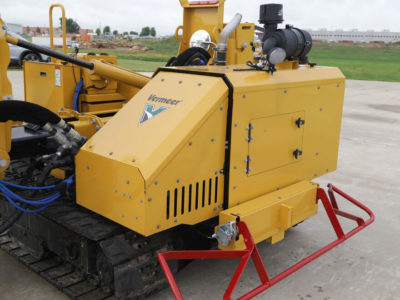In case you missed it, the latest feature on the Vermeer PD10R pile driver is called point-to-point. This technology lets you press a button and the remote-control-operated PD10R will travel and align itself to drive the next pile. This helps ease the pile-driving process by reducing the number of operational steps involved with navigating these machines on solar farm construction projects.
The point-to-point system works by syncing GPS coordinates with a digital project map of identified pile sites. After a pile is installed, the automation technology recognizes the next waypoint (pile location) on the map, then moves and positions itself into alignment. In addition, PD10R point-to-point models are equipped with bump bars on each end that stop machine movement when they encounter an obstacle.
The three bump bar positions
Let’s talk more about how these bump bars work. While it’s still up to the operator to avoid obstacles altogether, the bump bars are there in case it does get up against something.
The bump bars have three different positions on the PD10R. The first position is when it’s lifted all the way up horizontally. This is the default position for a PD10R when the point-to-point is not engaged.
The second position is when the bars are down at a 45-degree angle. This is where they should be when point-to-point is set and engaged. If the bars come into contact with anything, it will stop the machine in its tracks in that direction of travel. One plus to this is that you can back it up in the opposite direction of the obstacle, so you can maneuver around and keep going.
Bo Howell, an underground product specialist at Vermeer, explained some of the built-in sensitivity: “If you come into contact with the bump bars, it will stop the machine,” said Howell. “But it’s not so sensitive that weeds will trip the sensors.”
When the sensors do trip, the bars drop down completely vertical, which is the third position. To continue, you will manually lift up the bars back into the 45-degree position. Then you will honk the horn, which resets the tripped bump bar fault code and alerts others in the area that it’s time to move again.
A more convenient way
If you have a PD10R with a later serial number, these bump bars and the point-to-point system can be added on to the machine. Their purpose isn’t to replace the operator, but to help the operator throughout the day. This is a more convenient way to operate your pile driver, and the automation technology can help reduce operator fatigue and complacency over the course of the job.
The bump bars are there to protect your machine and aid the point-to-point technology as it automatically navigates from one pile to the next. “When using point-to-point, operator input is reduced to about eight steps, which also helps with new operator training,” explained Howell.
This may not always be the fastest way to move between piles, but it is a more repeatable process and an easier way to get things done. For more information on the point-to-point system for the PD10R, contact your local Vermeer dealer.
Vermeer Corporation reserves the right to make changes in engineering, design and specifications; add improvements; or discontinue manufacturing at any time without notice or obligation. Equipment shown is for illustrative purposes only and may display optional accessories or components specific to their global region. Please contact your local Vermeer dealer for more information on machine specifications.
Vermeer and the Vermeer logo are trademarks of Vermeer Manufacturing Company in the U.S. and/or other countries. © 2022 Vermeer Corporation. All Rights Reserved.
